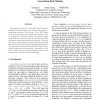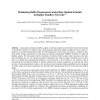268 search results - page 37 / 54 » Cleaning Interval Graphs |
195
Voted
ICDE
2006
IEEE
16 years 1 months ago
2006
IEEE
We propose a framework, called MIC, which adopts an information-theoretic approach to address the problem of quantitative association rule mining. In our MIC framework, we first d...
92
Voted
EACL
1993
ACL Anthology
15 years 1 months ago
1993
ACL Anthology
This paper presents a method for parsing associative Lambek grammars based on graphtheoretic properties. Connection graphs, which are a simplified version of proof-nets, are actua...
ACTAC
2007
15 years 18 days ago
2007
An o-line scheduling algorithm considers resource, precedence, and synchronisation requirements of a task graph, and generates a schedule guaranteeing its timing requirements. Th...
ALGORITHMICA
2010
15 years 18 days ago
2010
We divide a string into k segments, each with only one sort of symbols, so as to minimize the total number of exceptions. Motivations come from machine learning and data mining. F...
116
click to vote
VLSISP
2002
15 years 3 days ago
2002
Large-grain synchronous dataflow graphs or multi-rate graphs have the distinct feature that the nodes of the dataflow graph fire at different rates. Such multi-rate large-grain dat...


